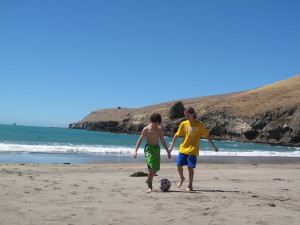We’ve made it to the other side of the globe, and the (sorry Minnesotans!) summery southern hemisphere! It’s been sunny and about mid-70s each day. Maybe it will make the winter sufferers to know there is a hole in the ozone here, so we’ve been sunburned despite liberal SPF 50 applications..? Maybe? OK, maybe not.
I started my role as a University of Canterbury Visiting Erskine Fellow in mid-February. It’s a huge honor to be invited back, as I had one in 2009 (which many people have pointed out to me is “before the earthquakes”.. a significant time horizon). Part of my role this term as an Erskine Fellow is to assist in teaching skill development and share different approaches with UC students. Along with colleague Sarah Wright, I am teaching an undergraduate Organizational Behavior course as well as an upper level Diversity course, the latter of which I have never taught as a stand-alone. I am hoping the experience I gain here will allow me to offer a course like this at Gustavus not only for E/M students but as a campus-wide offering. A key learning outcome for teaching practice here at UC is learning how to translate experiential learning methods to large lecture-driven sections, but there’s more to it for me. I have been fortunate in all of my teaching experiences since I started teaching college courses in 1997 that I have never been overwhelmed by huge sections of students. As higher ed contracts, however, and adjusts to the inevitable market-driven conditions it has resisted for..ever…, things will change. While my classes at Gustavus will almost certainly never approach 200 students, I want to see how my teaching practices and assumptions hold up under different circumstances.
Walking in the first day this week, seeing 200 OB students in a large lecture theatre was something to see. Sure, I have spoken to large crowds in theatre settings, and it’s not like it was unexpected. But those have been almost all one-off sessions where I did not have to engage the participants an entire teaching term. Similar to other first-days, I wanted to do some activities to signal that this course would be different; to get their attention that the same-old-same-old of passive lecturing would not be how this course would go.
Once we began an activity, students’ body language appeared to realize this was not their expected passive lecture theatre. They spoke! They spoke to me, they spoke to each other. As I walked up and down the steps, I had to bust one guy for surfing, but then he did put his screen away and participated (as far as I can tell). One thing that is quite different is my inability to hear what they are talking about if we have dyad or small group discussion– it’s just too loud. Certainly, some will be talking about the right stuff, but some won’t, which is true in any class but in a large class I suspect the proportion is higher.
It’s not just the sheer number of them that is at play here, and this is where I can take practical learning back to my ‘normal’ job at Gustavus. The students don’t know each other, so there is the social awkwardness factor between/among them. That could be the case in any student environment, and I have almost never taken time to do ice-breaker-types of activities for the social ice-cutting value itself. They have little or no experience talking about course material, so there is that hesitancy due to utter lack of practicing this skill (and it is a skill, for sure). They need to ramp up this competency, and what I might take for granted that North American students know how to do I cannot correlatively do here.
And there is the monitoring factor which neither Sarah nor I can do effectively: in smaller classes, when I walk around and lurk, I can listen in and hear what students are talking about, which is enormously helpful in the discussion as student-generated comments. I can hear whether students are on track, and share insights I think the entire class might enjoy. But, my physical presence also fosters a social control aspect of small group discussion, and keeps students on-task. I have not really ever thought about that aspect of my walking around, but I am sure it’s true. Particularly in the middle sections of theatre seats, there is no physical way to be present there. I did not observe less discussion therein, but this does make me wonder what they were talking about.
Too, the adjunct ‘test’ of their discussion is missing: I cannot call on someone in each group or dyad to share what they discussed. The back end of conversational learning—the conversation—is not supported in a large lecture setting. Maybe that is a modification that we need to make: some sort of reflective ending to the conversation on Moodle. That might close the loop, and being able to see in an asynchronous way what students are thinking would be very helpful, although once again, numbers will prevent us from looking at everyone’s comments.
I had to cold call on a guy only once for discussion responsing—risky for sure but I wanted to make sure they did not slide into passivity. It was about ¾ through class and I was worried about the energy. I think it was worth it, as there were great questions, even near the end. So I consider that a win, and a good signal to be sure to reinforce at next week’s class. Questions are good, and challenging answers is good.
One super interesting norm: once the slides end and the screen goes black, with the little “End of slide show, click to exit” prompt at the top, everyone immediately starts getting their things together to leave. It’s too loud, too many people, to stop the crescendo and momentum of everyone gathering their things, even when I am not quite done. Norms, too, are that in a large lecture theatre, once the slides for lecture are over, the class session is over. In a smaller class, if people are getting ready to leave and I ask a question, or invite comments, my presence as the instructor can still mostly overcome the shuffling and zippering sounds of people gathering their things. So that’s another change, and it also makes me consider how I am signaling the end of class in my Gustavus courses, too.
Seeing so many students at the beginning of a semester also makes me think about what pedagogical caring looks like in a large group. It seems to me that one side of instructor caring behaviors could still work: if a student comes to me with an issue, it does not matter how big the class is and I can help her or him with that. But how might it work to observe struggling students or disengaged students in such a large class? Is there a norm of not intervening, of letting them be, since there is no expectation or reward/sanction system in place for not only attendance but participation? It seems worth reflecting on that while in-class participation should be created to increase the probability of inclusion, we also need to respect those that opt out. I wonder if I should tell the students this. I could see it being both permission-giving as well as actually making students less willing to speak up for the potential stigma of being ‘called out’ even if it’s a self call out. So this is a continued reflection point for sure.
Among the most interesting discussion points this week were the questions about gender differences they discussed on the OB “quiz” activity, which introduces students to the debates in org behavior in a True or False way. There were three of gender-based questions (my favorite is: “Women are slightly more intelligent than men” which is fun but not based in evidence) and they generated the most binary opinions. Because of that, I will be facilitating an extra session about gender roles using the Lean In and Slaughter works. I had not planned on this type of session but it feels good to be organic and responsive to their interests.
It’s all good so far, and has been intense in getting up to speed in another system, and making another home. The boys’ initial trepidation over going to school has given way to great fun- the Kiwis engage with the outdoors more than most American schools do as an integrated part of the learning year. They have both made some friends, and can good-naturedly joke among themselves about our respective funny accents. The Black Caps, too, are in the hunt in the Cricket World Cup contest going on all over right now. NZ beat Australia yesterday which is always a celebration! Can’t understand cricket, can’t score it.. but everyone else seems to know when to cheer.


